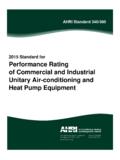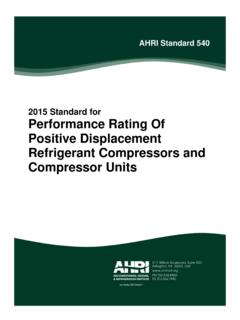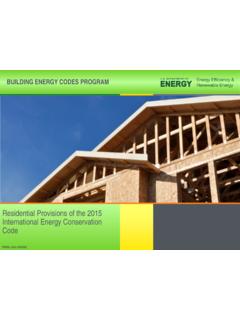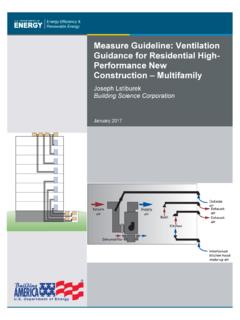Transcription of Significant Changes to the 2018 IECC - NV Office of Energy
1 Significant Changes to the 2018 IECC. 2018 IECC commercial Summary No notable change in efficiency over the 2015 IECC, only minor Changes o There were gains in efficiency, but an analysis has yet to determine specific amount. Early estimate between 2% to 5%. o Provided more detailed lighting control requirements. o Allowed Lighting Power Densities (LPD) were reduced approximately 20% to account for use of LED lighting. Specific commercial Proposals that Improve or Protect Energy Efficiency: Insulation component R-value-based method o Heated Slab Insulation.
2 R-5 insulation has been added as a requirement in Table for heated slabs in all climate zones. Assembly U-factor, C-factor or F-factor based method o Garage Door Glazing. A U-factor of .31 has been added to table as a minimum requirement for garage doors with glazing. Airspaces o Thermal Properties. When the thermal properties of airspaces are calculated as part of the thermal wall assembly, these airspaces must be enclosed in an unvented cavity designed to minimize airflow into and out of the cavity. Lighting Equipment o A proposal to increase the percentage of high efficacy lamps in permanently installed fixtures from 75% to 90% passed.
3 This will remain a mandatory requirement in the code. Service water-heating equipment performance efficiency o Water heater efficiencies. Updated to current federal water heater efficiencies. Lighting controls o Daylighting controls. Lighting systems shall be provided with controls that comply with Sections through , with exceptions. , , (NEW) Occupant sensor requirements o Expanded occupant sensor requirements to include open Office spaces. o Reduction allowed Light Power Densities (LPD) for interior and exterior lighting systems.
4 C406 Option Packages o Added option packages for increased envelope efficiency and reduced air leakage buildings. commercial Renewable Energy Cost Reduction o A maximum on-site renewable Energy cost reduction of 5% is now a component of the Performance based compliance approach. In addition to limiting the amount of renewable Energy offset. o Requires documentation which demonstrates the reduction in Energy use associated with on-site renewable Energy . o Clarifies that renewable Energy purchased from off-site sources shall be the same in the standard reference design and proposed design.
5 Editorial Revisions Adds clarifying language to the air barrier definition. Adds clarifying language to the air barrier construction section. Adds definition for cavity insulation. Revises definitions for skylights and vertical fenestration. Creates two new sections for below grade wall insulation and opaque doors. Reorganizes daylight zone requirements and clarifies requirements for top lit zones. Clarifies language in section Rooms Containing Fuel Burning Appliances. 2018 IECC Residential Summary Minor improvement over the 2015 IECC.
6 O Windows: improvement in the prescriptive path. o Energy Rating Index path. Negotiations between parties led to an easing of the Energy Rating Index Targets combined with improving thermal envelope requirements when using on-site renewables. Unclear Energy impact as it is unknown how many homes are following this path for code compliance and how many would incorporate on-site renewable Energy into the ERI calculation. Specific Residential Proposals that Reduce Energy Efficiency: Log Homes o Adds an exception to the residential thermal envelope requirements for log homes complying with ICC-400.
7 O This standard describes an alternative method for log home compliance with the building thermal requirements in the IECC. Residential Proposals that Improve or Protect Energy Efficiency: Table , Table Improved window efficiency o Lowers vertical fenestration U-factors in CZ 3 & 4 from to and CZ 5-8 from to Heated Slab Insulation o R-5 insulation has been added as a requirement in Table for heated slabs in all climate zones. Air Barrier & Insulation o Added language to the air barrier and insulation installation table will specify the following: Supply and return register boots must be sealed to the subfloor or drywall.
8 Recessed lighting must be sealed to the finished surface. Space behind electrical/phone boxes need to be insulated. o ICC/RESNET Standard 380 now referenced as envelope leakage testing option. Buried Ductwork in Attic o Ducts that are tested to have a maximum leakage rate of cfm25/100 SF to the outside, are insulated with R-8 insulation, and have at least R-19 insulation above and to the sides of the ducts, count as being in conditioned space. ERV/HRV Fan Efficiency o A minimum fan efficiency of cfm/watt has been added for HRV and ERVs.
9 Lighting Equipment o A proposal to increase the percentage of high efficacy lamps in permanently installed fixtures from 75% to 90% passed. This will remain a mandatory requirement in the code. Table Energy Rating Index o Target less stringent, but clarified role of on-site renewable Energy . o Increases maximum ERI scores from (51-55) to (57-62) and clarifies that where on-site renewable Energy is included for compliance, the building shall meet the mandatory requirements of and the thermal envelope shall meet or exceed the requirements of the 2015 IECC.
10 O ERI scores will be increased from 55 to 61 in CZ 5 and from 51 to 57 in CZ3. Where on-site renewable Energy is included in the ERI calculation, buildings must meet or exceed the thermal envelope requirements in Table of the 2015 . IECC. The 2009 IECC envelope backstop will remain in effect for buildings without on- site generation. RESNET Standards Referenced o The ANSI/RESNET/ICC 301-2014 is now a referenced standard in the code as the basis for the ERI calculation. Additionally, ANSI/RESNET/ICC 380-2016 is now a referenced standard for building envelope testing.







